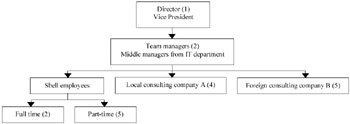SETTING THE STAGE
|
|
Because radical organizational change took place over a short period of time, many problems, including organizational and behavioral issues as well as application systems and information technology issues, arose. The challenges discussed next led the top management to initiate a strategic IT/IS plan in order to support the organizational change and to improve the capability of current IT application systems.
First of all, the current IT applications did not provide sufficient support for the revised organizational structure. For example, the two core competencies identified—research & development, and sales, marketing & service—were not well supported by the existing application systems. Without the help of IT, the strategic advantage that can be gained from the new organizational structure was limited.
Second, the current IT/IS structure needed significant improvement. The existing information systems could not satisfy the increasing demands for information sharing and data analysis. For example, problems in integrating legacy systems and the ERP system, and in information sharing within the ERP system, still existed. Some departments felt that the current application systems could not satisfy their specific functional requirements of day-to-day operations and decision-making, thus they began to build small-scale systems within their units without waiting for or obtaining approval from the top management. These isolated systems led to serious problems such as information conflicts and functional redundancy. Furthermore, the current information technical architecture could not support the decentralized structure of the extended organization. The current systems lacked the capability to manage, control and support multiple sites, and the ability to adapt to the changing environment. Moreover, without a centralized IT/IS department, the company felt an urgent need to build an effective and efficient IT organization to help the company develop its IT strategic plan, manage IT projects, and outline specific IT policies and rules.
Third, there was a high likelihood in the near future that Alcatel would acquire Sbell by becoming a majority shareholder and develop Sbell as one of its major global information technology research centers. Although the contract was still under negotiation at the time of the case, future integration problems concerning management, organization and technology should be considered. IT should be designed to support the potential merger with Alcatel.
Facing the above problems, the top management decided to develop an enterprise-wide strategic information systems plan in early 2001 to achieve the following objectives:
-
Update Shanghai Bell's IT vision and strategy to align with its evolving business objectives;
-
Develop an appropriate application architecture that would meet its long-term growth objectives;
-
Develop an appropriate technical architecture that would ensure interoperability and integration between existing and emerging systems, and provide appropriate linkage to key business strategies; and
-
Assess and design an information services organizational structure to help meet its long-term objectives.
In the middle of February 2001, a kickoff meeting was held among the top management to initiate the Strategic Information Systems Planning (SISP) process. A project team was set up, and was directly led by a Vice President (VP) and two managers from the Information Center and the IT department of Sbell. To facilitate the implementation of SISP, the company suspended all of its application systems projects under development, and declared not to approve any IS budget until the end of the SISP project.
In March 2001, two IT consulting companies were selected to assist in the SISP project. One of the consulting companies (company A) is a domestic company that has extensive knowledge of Chinese corporations and rich experience in developing strategic information systems plan in the telecommunication industry. The other (company B) is a well known American-based IT consulting company that has a good reputation, an extensive knowledge base, and a proven methodology for SISP. "We selected company A for its strong communication skills and rich experience in dealing with IT strategic issues in domestic industries," according to the Vice President, Mr. Zhiqun Xu. He continued, "As for company B, we chose it because of its strong IT background and specialization in IT strategic consulting. In addition, it is also viewed as being ‘unbiased’ in software and hardware selections and recommendations. Company B does not have its own proprietary application products, so it is more likely to recommend the most appropriate products rather than in line with its vested interest. We hope that the two consulting companies can work closely with our employees, to bring new concepts and ideas to the company and to educate our staff."
A Vice President, two middle managers, four consultants from consulting company A, five from consulting company B, two full-time Sbell employees and five other part-time personnel from key departments, made up the core SISP project team (as shown in Figure 5).

Figure 5: Organization Structure of SISP Project Team
|
|
EAN: 2147483647
Pages: 367